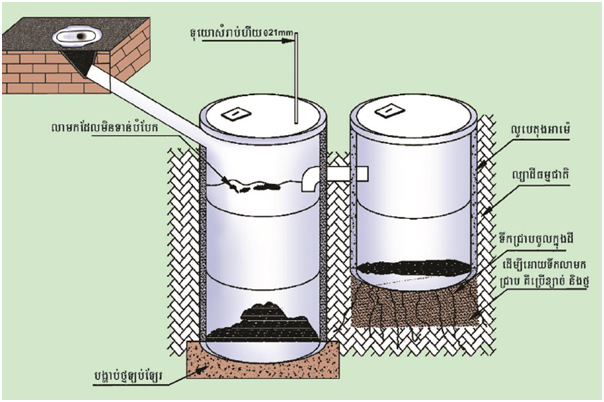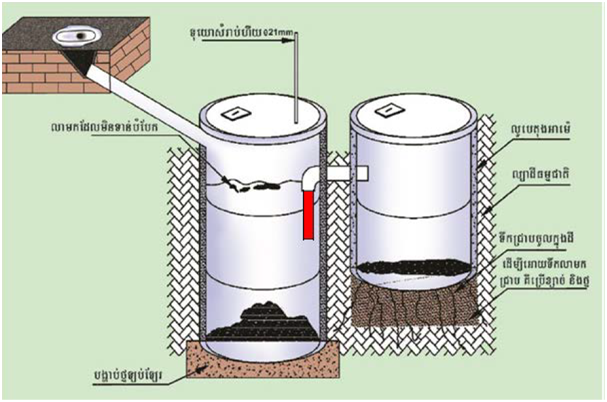- Forum
- categories
- Sanitation systems
- Toilets without urine diversion
- Pit latrines (simple, VIP, dual pit, pour flush)
- latrine technology question about the use of two chamber rural latrine septic tanks
latrine technology question about the use of two chamber rural latrine septic tanks
11.2k views
- Emilio
-
Less
- Posts: 8
- Likes received: 4
Re: latrine technology question about the use of two chamber rural latrine septic tanks
hi
As Florian said water is not safe or pathogene free, the first chamber just retains suspended and floating solids. Now the water table depth at 1.5 - 2 m seems quite superficial, and in case of heavy rain it may flood specially if soil infiltration rate is low.
Under this conditions a two pit latrine may not be the best solution.
Please give more details on the site you are working
regards
Emilio
As Florian said water is not safe or pathogene free, the first chamber just retains suspended and floating solids. Now the water table depth at 1.5 - 2 m seems quite superficial, and in case of heavy rain it may flood specially if soil infiltration rate is low.
Under this conditions a two pit latrine may not be the best solution.
Please give more details on the site you are working
regards
Emilio
Please Log in to join the conversation.
You need to login to replyRe: latrine technology question about the use of two chamber rural latrine septic tanks
rhockkh wrote: From the guidance I'm receiving from this forum and other sources, it seems that the use of this baffle if correctly placed, will allow for safer water to drain into the second soakaway tank. Would you agree?
Hi Richard,
as Emilio also explained, yes, it would be good to have an elbow or a T between the two tanks. Proper placement of the connecting pipe is part of the good technical design of the two chamber system. A properly placed connecting pipe allows achieving the indended better solids retention in the first tank, the liquid passing to the second tank being mostly solids free, which protects the soak pit of clogging.
However, while the liquid is solids free, it is not necessarly more "safe" in the sense of being less harmfull to the environment or human health (as I tried to explain above). So, distances to wells etc. should be the same as for single tank systems.
Lastly, let me also stress the importance to put a management system in place for regular desludging of the tanks. If they aren't desludged every few years, they become full, solids will pass over to the soak pit (just as with badly placed connecting pipes), soak pits will clogg and will need to be relaced. Without good management, the investment in the more expensive two chamber system makes not much sense.
Best regards,
Florian
Please Log in to join the conversation.
You need to login to reply- rhockkh
-
 Topic Author
Topic Author- Primarily interested in the links between WASH, Nutrition, Food Security and Behaviour Change
Less- Posts: 7
- Likes received: 1
Re: latrine technology question about the use of two chamber rural latrine septic tanks
Hi Emilio, thanks for the information:
I'm aware of the need to use a T, and we are looking at how our budget can accommodate this.
We have taken into account the population density and Sphere standards for the distance from drinking water sources and the location of the latrines. Soil characteristics are generally good and the water table is between 1.5 and 2ms below the surface.
From the guidance I'm receiving from this forum and other sources, it seems that the use of this baffle if correctly placed, will allow for safer water to drain into the second soakaway tank. Would you agree?
Best
Richard
I'm aware of the need to use a T, and we are looking at how our budget can accommodate this.
We have taken into account the population density and Sphere standards for the distance from drinking water sources and the location of the latrines. Soil characteristics are generally good and the water table is between 1.5 and 2ms below the surface.
From the guidance I'm receiving from this forum and other sources, it seems that the use of this baffle if correctly placed, will allow for safer water to drain into the second soakaway tank. Would you agree?
Best
Richard
Posted by a freelance development consultant.
Please Log in to join the conversation.
You need to login to reply- Emilio
-
Less
- Posts: 8
- Likes received: 4
Re: latrine technology question about the use of two chamber rural latrine septic tanks
the bafle between the two chambers is to,(as noted) prevent floating solids and scum to pass to the second chamber but tecnically is better to use a T than an elbow as with a T it is possible to clean or declog opening the lid without trouble.
The use of a second chamber or a direct conection to a soak away and the pollution of water table depends on the population density (how many toilets per hectare and how many people use one toilet), available space for infiltration, soil caracteristics and the depth of the water table. There is also in function of the aforementioned conditions a minimum distance from the pit to the water well
By design it is admited than this type of latrines use 2-3 liters water at the most per flush then the water volume to dispose is small compared to a home septic tank where other waste water is recieved. For more details see Wagner and Lannoix Excreta disposal for rural areas and small comunities WHO 1958 ( apps.who.int/iris/handle/10665/41687)
downloadable from this link
The use of a second chamber or a direct conection to a soak away and the pollution of water table depends on the population density (how many toilets per hectare and how many people use one toilet), available space for infiltration, soil caracteristics and the depth of the water table. There is also in function of the aforementioned conditions a minimum distance from the pit to the water well
By design it is admited than this type of latrines use 2-3 liters water at the most per flush then the water volume to dispose is small compared to a home septic tank where other waste water is recieved. For more details see Wagner and Lannoix Excreta disposal for rural areas and small comunities WHO 1958 ( apps.who.int/iris/handle/10665/41687)
downloadable from this link
Please Log in to join the conversation.
You need to login to reply- rhockkh
-
 Topic Author
Topic Author- Primarily interested in the links between WASH, Nutrition, Food Security and Behaviour Change
Less- Posts: 7
- Likes received: 1
Re: latrine technology question about the use of two chamber rural latrine septic tanks
Dear Florian,
Thanks for your response - very interesting.
Essentially, I'm wondering if the additional piping (see red pipe in attachment 2) will ensure that 'safer' water will drain into the second soakaway tank than the original piping set up in attachment 1?
Richard
Thanks for your response - very interesting.
Essentially, I'm wondering if the additional piping (see red pipe in attachment 2) will ensure that 'safer' water will drain into the second soakaway tank than the original piping set up in attachment 1?
Richard
Posted by a freelance development consultant.
Please Log in to join the conversation.
You need to login to replyRe: latrine technology question about the use of two chamber rural latrine septic tanks
Hi Richard,
The baffle separates the tank in two compartments (some design have even 3 compartments), which helps retaining solids, either sludge sinking to the bottom or floating scum. The clarified liquid can be further treated or infiltrated. After a certain period, accumulated solids need to be pumped out, as otherwise volume for accumulation would become too small and solids start to be carried over to the next chamber or the soak pit.
Single chamber systems are less efficient for retaining solids, so more solids start entering earlier in the soak pit, where over time they lead to clogging.
The main difference between a well designed two-chamber septic tank and a single chamber tank is the life time: if the 2-chamber tank is properly maintained (desludged according to design intervalls) its lifetime is basically unlimited. A single chamber system will becomed clogged at some time (how fast depends on soil characteristics) and need to be replaced.
As for the contamination of groundwater, there is no difference between a one or a two chamber system. In a one chamber system, the solids will also be retained, just in the soil matrix around the soak pit rather in the tank itself. In both system, clarified wastewater (containing up to 50 % of the total BOD and still an important load of pathogens) will infiltrate and may contaminate the groundwater. If contamination of groundwater is really a problem depends of densitiy of the septic tanks, of soil properties, and of the type of use of the groundwater.
It's a bit different if the tanks do not drain into a soak pit but into suface water or a drainage ditch. Then pollution from single chamber systems (or badly maintained two-chamber systems) is definitely worse than from well maintained two-chamber septic tanks.
This is all generally speaking. I'm not so sure what exactly is the situation you are dealing with. Your attachment 2 shows the same as 1, also a 2 chamber system, just with some difference in the placement of the pipe connecting the two chamber.
I know that in Cambodia (and elsewhere) single chamber systems, soak pits are common in rural pour flush latrines. These fill up after some time and need to be replaced (often designes foresee two of such pits, to be used alternatively.
Regards, Florian
The baffle separates the tank in two compartments (some design have even 3 compartments), which helps retaining solids, either sludge sinking to the bottom or floating scum. The clarified liquid can be further treated or infiltrated. After a certain period, accumulated solids need to be pumped out, as otherwise volume for accumulation would become too small and solids start to be carried over to the next chamber or the soak pit.
Single chamber systems are less efficient for retaining solids, so more solids start entering earlier in the soak pit, where over time they lead to clogging.
The main difference between a well designed two-chamber septic tank and a single chamber tank is the life time: if the 2-chamber tank is properly maintained (desludged according to design intervalls) its lifetime is basically unlimited. A single chamber system will becomed clogged at some time (how fast depends on soil characteristics) and need to be replaced.
As for the contamination of groundwater, there is no difference between a one or a two chamber system. In a one chamber system, the solids will also be retained, just in the soil matrix around the soak pit rather in the tank itself. In both system, clarified wastewater (containing up to 50 % of the total BOD and still an important load of pathogens) will infiltrate and may contaminate the groundwater. If contamination of groundwater is really a problem depends of densitiy of the septic tanks, of soil properties, and of the type of use of the groundwater.
It's a bit different if the tanks do not drain into a soak pit but into suface water or a drainage ditch. Then pollution from single chamber systems (or badly maintained two-chamber systems) is definitely worse than from well maintained two-chamber septic tanks.
This is all generally speaking. I'm not so sure what exactly is the situation you are dealing with. Your attachment 2 shows the same as 1, also a 2 chamber system, just with some difference in the placement of the pipe connecting the two chamber.
I know that in Cambodia (and elsewhere) single chamber systems, soak pits are common in rural pour flush latrines. These fill up after some time and need to be replaced (often designes foresee two of such pits, to be used alternatively.
Regards, Florian
Please Log in to join the conversation.
You need to login to reply- rhockkh
-
 Topic Author
Topic Author- Primarily interested in the links between WASH, Nutrition, Food Security and Behaviour Change
Less- Posts: 7
- Likes received: 1
latrine technology question about the use of two chamber rural latrine septic tanks
Dear Colleagues,
I have a latrine technology question about the use of two chamber rural latrine septic tanks (see attachment 1).
It has been suggested to me that it is very important to include a ‘baffle’ (see attachment 2) inside the first sealed tank to drain blackwater from the middle of the tank into the second soakaway tank.
This ‘baffle’ needs to drain water from the middle of the tank. It is very important for the connecting pipe not to drain blackwater from the top of the first tank as this will drain scum floating on and slightly below the water surface. The water that is then drained into the second soakaway tank from the middle of the first tank will be much safer to be then allowed to discharge into the local water table – approximately 70% harmless was quoted to me.
My question is why this ‘baffle’ is not a prominent feature of all septic tank designs used in Cambodia (where I currently work) – as in attachment 1 above where it is present but not to the specifications in attachment 2 (or as detailed in the literature)?
And why are single tank designs promoted in Cambodia that seem to take no account of the potential to contaminate local water tables?
Looking forward to any insight on this.
Best regards
Richard Hocking
Development Professional
Siem Reap
Cambodia
I have a latrine technology question about the use of two chamber rural latrine septic tanks (see attachment 1).
It has been suggested to me that it is very important to include a ‘baffle’ (see attachment 2) inside the first sealed tank to drain blackwater from the middle of the tank into the second soakaway tank.
This ‘baffle’ needs to drain water from the middle of the tank. It is very important for the connecting pipe not to drain blackwater from the top of the first tank as this will drain scum floating on and slightly below the water surface. The water that is then drained into the second soakaway tank from the middle of the first tank will be much safer to be then allowed to discharge into the local water table – approximately 70% harmless was quoted to me.
My question is why this ‘baffle’ is not a prominent feature of all septic tank designs used in Cambodia (where I currently work) – as in attachment 1 above where it is present but not to the specifications in attachment 2 (or as detailed in the literature)?
And why are single tank designs promoted in Cambodia that seem to take no account of the potential to contaminate local water tables?
Looking forward to any insight on this.
Best regards
Richard Hocking
Development Professional
Siem Reap
Cambodia
Posted by a freelance development consultant.
Attachments:
-
 attachment1.png
(Filesize: 256KB)
attachment1.png
(Filesize: 256KB)
-
 attachment2.png
(Filesize: 266KB)
attachment2.png
(Filesize: 266KB)
Please Log in to join the conversation.
You need to login to reply
Share this thread:
- Forum
- categories
- Sanitation systems
- Toilets without urine diversion
- Pit latrines (simple, VIP, dual pit, pour flush)
- latrine technology question about the use of two chamber rural latrine septic tanks
Recently active users. Who else has been active?
Time to create page: 0.083 seconds








